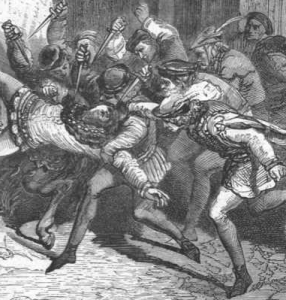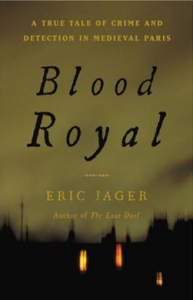 By Eric Jager (Guest Contributor)
By Eric Jager (Guest Contributor)
In the 1660s, a curious parchment scroll was discovered at an old château in the south of France. It was a police report on the 1407 murder of Louis of Orleans, brother of the insane king, hacked to death one night in a Paris street. In it was an autopsy report, detailed notes on the case, and numerous witness statements taken by investigators. The scroll had been compiled by the city provost or chief of police, Guillaume de Tignonville. After thirty feet, it abruptly ended. Guillaume had sprung a trap eliciting a confession from a member of the royal family. He was now in danger, and the nation was headed for civil war.
A Rare Look into Medieval Investigations
The scroll, compiled in the turbulent days after the crime, reads like a police procedural, detailing how Guillaume and his officers closed the city gates, examined the crime scene, scoured Paris for evidence, and summoned dozen of ordinary Parisians to give statements. It offers a rare inside look at a medieval crime investigation, letting us hear the voices of long-dead Parisians caught up in great events and otherwise lost to history. We hear, for example, the vivid testimony of Jacquette Griffard, a shoemaker’s wife who watched in horror from her window as the band of masked assassins attacked Louis in the street below:
I saw the great lord on his knees in the middle of the street, in front of the door of the house of Marshal Rieux. His head was bare, and he was surrounded by seven or eight men. They all had masks — I couldn’t see their faces — and they were holding swords and axes. I couldn’t see the horses anymore. The men began striking the lord with their weapons. He raised his arm once or twice over his head, saying, “What is this? What are you doing?” No one answered.
Soon the lord fell down in the street and lay there, while the men kept hitting him with their swords, cut and thrust, as hard as they could, as if they were beating an old mattress.
I yelled out as loudly as I could: “Murder! Murder!”
One of the men in the street looked up and shouted: “ Shut up, you damned woman! Shut up!”
Along with Jacquette, more than three dozen witnesses were summoned — clerks, barbers, shopkeepers, and other housewives. Through their testimony we see the bustling neighborhood of the Marais before the crime, the moonless night of the murder, and the immediate aftermath as the assassins galloped away through the darkened streets. But these and other details were nearly lost when the scroll went missing at some point after the events. It was recovered years later largely by accident.
A Serendipitous Discovery
In the 1660s, Jean de Doat, a government official, directed a vast project to preserve thousands of old manuscripts scattered among archives and abbeys in southern France. With the support of Louis XIV’s finance minister, Jean-Baptiste Colbert, Doat hired dozens of copyists who crisscrossed the land in search of France’s forgotten patrimony.
One of the manuscripts found by the scribes was the 1407 scroll. It turned up in Pau among the papers of Charles d’Albret, Constable of France at the time of Louis’s murder and the official who first alerted Guillaume to the crime. In 1666, a scribe made a copy that was sent to Paris for safekeeping but soon fell into obscurity. In the 1730s, the Doat collection was absorbed by the royal library. The copy, like the original, was nearly forgotten.
But someone had noticed it. In the 1740s, the royal librarian, the Abbé Sallier, mentioned the copy to a scholar named Pierre Bonamy, who had been looking for records of old houses in Paris. Retrieving the document, Bonamy was amazed to find that it contained long-lost details of Louis’s murder and the provost’s investigation. Like a torch suddenly ignited in the dark, new light fell on an infamous crime. (Imagine finding the Zapruder film of JFK’s assassination decades later in a drawer!)
Bonamy presented a paper to the Royal Academy in 1748, including excerpts from Guillaume’s report. One of the eyewitness accounts he read aloud was that of Jacquette, the shoemaker’s wife, bringing her voice back to life after centuries of silence. When Bonamy’s paper was printed six years later, the hidden history of Louis’s murder, at least in part, became available to the world.
Originals, Copies, and Textual Survival
But back in the south of France, the original scroll had fallen back into obscurity. Not until the 1860s did it come to light again, when Paul Raymond, a curator at the archives in Pau, stumbled upon it while cataloguing the Albret family papers. Like Bonamy more than a century earlier, Raymond recognized his stupendous find and promptly published a full transcript.
Thanks to Guillaume, one of history’s first detectives, we have the original scroll. And thanks to Doat, Bonamy, and Raymond, we have a transcript in Paris and another in print — and online. Anyone around the world can look it up and time-travel back to Paris six centuries ago. Who knows what else modern sleuths will discover there?
 Eric Jager teaches medieval literature at UCLA. He is the author of four books, including Blood Royal and The Last Duel, a story of trial by combat in medieval France.
Eric Jager teaches medieval literature at UCLA. He is the author of four books, including Blood Royal and The Last Duel, a story of trial by combat in medieval France.
